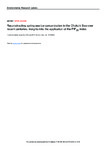Reconstructing spring sea ice concentration in the Chukchi Sea over recent centuries: insights into the application of the PIP25 index
| dc.contributor.author | Kim, J-H | |
| dc.contributor.author | Gal, J-K | |
| dc.contributor.author | Jun, S-Y | |
| dc.contributor.author | Smik, L | |
| dc.contributor.author | Kim, D | |
| dc.contributor.author | Belt, Simon | |
| dc.contributor.author | Park, K | |
| dc.contributor.author | Shin, K-H | |
| dc.contributor.author | Nam, S-I | |
| dc.date.accessioned | 2020-01-14T16:30:15Z | |
| dc.date.issued | 2019-11-27 | |
| dc.identifier.issn | 1748-9326 | |
| dc.identifier.issn | 1748-9326 | |
| dc.identifier.other | 125004 | |
| dc.identifier.uri | http://hdl.handle.net/10026.1/15303 | |
| dc.description.abstract |
<jats:title>Abstract</jats:title> <jats:p>In this study, we aimed to reconstruct spring (April–June) sea ice changes in the western Arctic Ocean over recent centuries (ca. the last 250 years) by measuring biomarker distributions in a multicore (ARA01B-03MUC) retrieved from the Chukchi Shelf region and to evaluate outcomes against known or modelled estimates of sea ice conditions. Specifically, we analyzed for the Arctic sea ice proxy IP<jats:sub>25</jats:sub> and assessed the suitability of a further highly branched isoprenoid (HBI) lipid (HBI III), epi-brassicasterol, and dinosterol as complementary biomarkers for use with the so-called phytoplankton marker-IP<jats:sub>25</jats:sub> index (PIP<jats:sub>25</jats:sub>; P<jats:sub>III</jats:sub>IP<jats:sub>25</jats:sub>, P<jats:sub>B</jats:sub>IP<jats:sub>25</jats:sub>, and P<jats:sub>D</jats:sub>IP<jats:sub>25</jats:sub>, respectively). The presence of IP<jats:sub>25</jats:sub> throughout core ARA01B-03MUC confirms the occurrence of seasonal sea ice at the study site over recent centuries. From a semi-quantitative perspective, all three PIP<jats:sub>25</jats:sub> indices gave different trends, with some dependence on the balance factor <jats:italic>c</jats:italic>, a term used in the calculation of the PIP<jats:sub>25</jats:sub> index. P<jats:sub>III</jats:sub>IP<jats:sub>25</jats:sub>-derived spring sea ice concentration (SpSIC) estimates using a <jats:italic>c</jats:italic> value of 0.63, determined previously from analysis of Barents Sea surface sediments, were likely most reliable, since SpSIC values were high throughout the record (SpSIC > 78%), consistent with the modern context for the Chukchi Sea and the mean SpSIC record of the 41 CMIP5 climate models over recent centuries. P<jats:sub>B</jats:sub>IP<jats:sub>25</jats:sub>-based SpSIC estimates were also high (SpSIC 108%−127%), albeit somewhat over-estimated, when using a <jats:italic>c</jats:italic> value of 0.023 obtained from a pan-Arctic distribution of surface sediments. In contrast, P<jats:sub>D</jats:sub>IP<jats:sub>25</jats:sub> values using a pan-Arctic <jats:italic>c</jats:italic> value of 0.11, and PIP<jats:sub>25</jats:sub> data based on the mean biomarker concentrations from ARA01B-03MUC, largely underestimated sea ice conditions (SpSIC as low as 13%), and exhibited poor agreement with instrumental records or model outputs. On the other hand, P<jats:sub>B</jats:sub>IP<jats:sub>25</jats:sub> values using a <jats:italic>c</jats:italic> factor based on mean IP<jats:sub>25</jats:sub> and epi-brassicasterol concentrations exhibited a decline towards the core top, which resembled recent decreasing changes in summer sea ice conditions for the Chukchi Sea; however, further work is needed to test the broader spatial generality of this observation.</jats:p> | |
| dc.format.extent | 125004-125004 | |
| dc.language.iso | en | |
| dc.publisher | IOP Publishing | |
| dc.subject | sea ice | |
| dc.subject | HBIs | |
| dc.subject | IP25 | |
| dc.subject | epi-brassicasterol | |
| dc.subject | dinosterol | |
| dc.subject | PIP25 index | |
| dc.subject | Chukchi Sea | |
| dc.title | Reconstructing spring sea ice concentration in the Chukchi Sea over recent centuries: insights into the application of the PIP25 index | |
| dc.type | journal-article | |
| dc.type | Journal Article | |
| plymouth.author-url | https://www.webofscience.com/api/gateway?GWVersion=2&SrcApp=PARTNER_APP&SrcAuth=LinksAMR&KeyUT=WOS:000499326800001&DestLinkType=FullRecord&DestApp=ALL_WOS&UsrCustomerID=11bb513d99f797142bcfeffcc58ea008 | |
| plymouth.issue | 12 | |
| plymouth.volume | 14 | |
| plymouth.publication-status | Published | |
| plymouth.journal | Environmental Research Letters | |
| dc.identifier.doi | 10.1088/1748-9326/ab4b6e | |
| plymouth.organisational-group | /Plymouth | |
| plymouth.organisational-group | /Plymouth/Faculty of Science and Engineering | |
| plymouth.organisational-group | /Plymouth/Faculty of Science and Engineering/School of Geography, Earth and Environmental Sciences | |
| plymouth.organisational-group | /Plymouth/REF 2021 Researchers by UoA | |
| plymouth.organisational-group | /Plymouth/REF 2021 Researchers by UoA/UoA07 Earth Systems and Environmental Sciences | |
| plymouth.organisational-group | /Plymouth/Research Groups | |
| plymouth.organisational-group | /Plymouth/Research Groups/Marine Institute | |
| plymouth.organisational-group | /Plymouth/Users by role | |
| plymouth.organisational-group | /Plymouth/Users by role/Academics | |
| plymouth.organisational-group | /Plymouth/Users by role/Researchers in ResearchFish submission | |
| dcterms.dateAccepted | 2019-10-07 | |
| dc.rights.embargodate | 2020-1-16 | |
| dc.identifier.eissn | 1748-9326 | |
| dc.rights.embargoperiod | Not known | |
| rioxxterms.versionofrecord | 10.1088/1748-9326/ab4b6e | |
| rioxxterms.licenseref.uri | http://www.rioxx.net/licenses/all-rights-reserved | |
| rioxxterms.licenseref.startdate | 2019-11-27 | |
| rioxxterms.type | Journal Article/Review |


